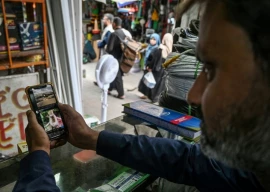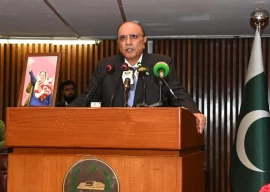
Picking apart the rhetoric and formulaic addresses to the plenary session of the Saarc summit in Kathmandu is neither easy nor likely to be precise. With two of the Saarc member states — India and Pakistan — locked in interminable antagonism and a low-key war on the Siachen glacier and along parts of the Line of Control, expressions by both of emollient sentiments in the Saarc context seem at best fatuous. Prime Minister Nawaz Sharif called for the realisation of his own vision of South Asia as a dispute-free region despite it being gripped by the lowest human and social indicators in the world, and poverty disease and illiteracy. The countries of Saarc are home to a quarter of the world’s population and account for six per cent of global GDP when viewed as purchasing power parity and this is one of the least integrated regions in the world. There is nothing to disagree with in terms of what the prime minister said, but credulity has to be stretched by his vision which may hold true in the very broad context of a Saarc summit but is far removed from reality.

On a similar note, the commitment by the Indian prime minister to give business visas for three to five years for residents of Saarc countries on the face of it looks to be welcome — but will this apply across the board? If business visas are to be granted to all Saarc countries by India, is that going to mean there is a reciprocal commitment to grant visas to Indian residents by all other Saarc countries, including Pakistan? These are questions as yet unanswered but if the collective Saarc visa regime were to be freed up, the unlocking of potential across the region would be considerable, as would the potential for lowering tensions. This could be nothing more than Prime Minister Modi dreaming out loud, and clarity would be much desired. Where the Indian prime minister was indisputably correct was in his saying that nowhere in the world are collective efforts more urgently needed than in South Asia, and nowhere else are they so modest. A wakeful Saarc would indeed be welcome.
Published in The Express Tribune, November 27th, 2014.
Like Opinion & Editorial on Facebook, follow @ETOpEd on Twitter to receive all updates on all our daily pieces.
COMMENTS (14)
Comments are moderated and generally will be posted if they are on-topic and not abusive.
For more information, please see our Comments FAQ























































@ Blackhat
Afghanistan is already using Chabahar port in Iran and since Pakistan reneges on APTTA it is only natural for Afghanistan to exploit the Northern Distribution Network.
Afghanistan is not sitting by idly while Pakistan entertains grand delusions like strategic depth. The only country being isolated is Pakistan.
India has already implemented electronic tourist Visa on arrival for 43 countries.
The TVoA enabled with ETA Scheme will facilitate nationals of 43 countries including Australia, Brazil, Cambodia, Cook Islands, Djibouti, Federated States of Micronesia, Fiji, Finland, Germany, Indonesia, Israel, Japan, Jordan, Kenya, Kingdom of Tongo, Laos, Luxembourg, Mauritius, Mexico, Myanmar, New Zealand, Niue, Norway, Oman, Palestine, Papua & New Guinea, Philippines, Republic of Kiribati, Republic of Korea (i.e. South Korea), Republic of Marshall Islands, Republic of Nauru, Republic of Palau, Russia, Samoa, Singapore, Solomon Islands, Thailand, Tuvalu, UAE, Ukraine, USA, Vietnam and Vanuatu.
Business visa to the residents of SAARC countries will facilitate and accelerate trade among the region.
Time to switch from multilateral relationships to bilateral relationship
India and Pakistan don't have anything in common. Their ideology are actually opposite. There will be no peace until Pakistan is divided into very small peaces so that it can never play any game ever.
@pappu ali: Not in life. Any one on helm of affairs in Pakistan aught to be puppet in the hands of COAS. It is complicated issue and can not be resolved so easily. Nation has to have leader like Turkish President which one can not see in pipe line.
SAARC is sick. Terminally ill. Pakistan not being contiguous to other members, except for Afghanistan, it can not benefit from being a member of this association. It hasn't implemented any of the agreements till now, making it a defaulter as per the rules. It should quit. In line with its desire, it should found 'Counter SAARC' with China, making Gwadar the headquarters. This will also isolate Afghanistan providing 'strategic depth'.
Nawaz speech is clear that Pakistan FO is controlled by Military and nowadays by even China.
SAARC summits are being used only as photo sessions by the Pakistan. It neither participates in meaningful discussions nor takes followup actions on the decisions taken. Hence it may be dropped from the grouping. If corrective actions are not taken, I see a possibility of next SAARC summit without Pakistan.
The reality of SAARC - IT IS DEAD.
It was created with certain objectives and it has hopelessly failed. India-Pakistan tension is at the bottom of it.
India should relegate SAARC to a 'TV debate' forum. And it should make a new forum for regional co-operation involving just the countries that aren't in conflict with India - Srilanka, Bangladesh, Nepal, Bhutan (and perhaps even Burma). Free trade & easy travel arrangements can improve relations as well as economies in this region.
modi has already said that we all need to grow together,pakistan need to stop blocking trade agreement which benfits all members of saarc,if pakistan is really serious than nawaz must act on what he says on reginol coperation
The edit managed to obscure the most important reality --- that Pakistan painted itself into a corner by refusing to sign three multi-lateral pacts on connectivity and power. The isolation even in SAARC is yet another pointer that Pakistan is swimming against the tide of the history.
If business visas are to be granted to all Saarc countries by India, is that going to mean there is a reciprocal commitment to grant visas to Indian residents by all other Saarc countries, including Pakistan? . Yeah - what's the big deal - it's called reciprocity and something that is implied in the suggested deal.
Let us hope Pakistani leadership will do right by it's poor and enable trade, travel and commerce between SAARC.
nawaz sharrif is puppet in real life.